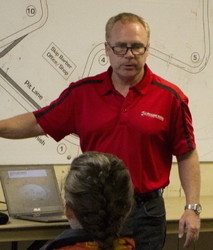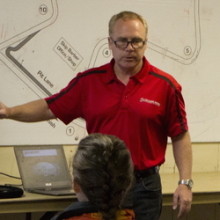Ask a pro
Receive advice directly from today’s top stars


Allen Berg
Driver training expert and former F1 driver
Allen Berg, driver training expert and former F1 racer is the latest online driving instructor for SAFEisFAST.com.
Berg is the current President and chief instructor at Allen Berg Racing Schools, where he and his team teach young aspiring drivers the fundamental skills needed to control a race car, as well as numerous other valuable driving techniques.
Berg had a successful motor racing career, competing in Formula One, Formula Two, Formula Three, Formula Atlantic, Sport Prototypes and Touring Cars.
Allen Berg answers your questions!
-
Michael K
Hello Allen, The “rate” of a driver’s input seems to be an important factor in performing well. How would you advise a driver to work on this both on and off track?




Hello Michael. The driver’s input is a crucial factor in developing overall performance. If the driver can provide the team with accurate and reliable feedback about racecar handling and troubleshooting problems, the team will more effectively be able to develop a competitive and reliable racecar.
The best way that a driver can improve his feedback is working methodically with the engineer in debriefing meetings after each session. The engineer questions the driver on the car’s handling corner-by-corner, segment by segment, normally with the engineer taking notes. I do recommend that drivers create track maps after each on-track session (as described further down), to note the racecars specific handling characteristics.
Data systems are a great tool for driver and chassis development. It is important for the driver to be able to manipulate and understand data and data systems without aid from the data tech or engineer to review his performance. This can also be taken away to review at the hotel or back home between race and practice events.
Many years ago I was working with a race engineer and I did not agree with his approach to car set up. I received some sound advice from my dad who was with me at the time. “Allen if you do not like what the engineer is doing to your car, then take control of it and request specific changes yourself. You will have a better chance of improving the car set up this way and if the racecar is no better than before at least it is because of your own decisions, not someone else’s.” In the end this worked out very well for me. However with today’s racecars this may no longer be a viable solution as the engineers all use spreadsheets for the overall car set up. However it is vitally important that the driver have a complete understanding of the chassis and set up to become an integral part of the racecar development.
-
John Smith
What’s the best way for me to get a shot in Motorsport? I’ve been sim racing now for about 3 years and learnt a lot throughout that time and I believe in my own talent. I’m able to post lap times that are on occasions in the top 10 of the world without any driver training whatsoever and no knowledge of how to tune a car properly and to suit your own driving style. My trouble is I’m not from the wealthiest of backgrounds.




Hello John. The fact that you are able to set times with only three years experience simulator racing is very impressive.
My personal feeling about simulators is it can give an indication as to abilities, however it is not always 100% accurate. I have seen very good drivers that are unable to perform on simulators and drivers that have done well on the simulator and not being able to replicate it in a racecar.
My suggestion for you John is to look at karting. I suggest you should seek out the local kart club and look into the most popular racing category in that club. Hopefully that will be a four-cycle category as two-cycle racing can get extremely expensive. You can buy a used kart at a reasonable price and pick up a good four-cycle motor that will last you a long time. Karting is by far the most cost effective form of racing.
SAFEisFAST video: Karts to Cars
-
Canaan McKoy
It was a rainy day and I spun out in turn 9 at Laguna Seca. It was my first real rain day. Any good books that help people drive in the rain better and what is the best overall street performance tire that does well in the rain?




Canaan I find that turn 9 is one of the most challenging turns on that difficult and very fast track. When I conduct the morning track walks at the school I always suggest that for turn 9 the driver considers the cornering speed in anticipation of the exit of the corner in mind.I learned a great technique ice racing years ago from a seasoned rally driver that I use throughout my career whenever I drove in rain conditions. If you have lost control and going into a spin, if you can do this soon enough you may recover control: Push in the clutch (in a manual transmission racecar) and come off the brake and throttle. By doing so you will allow the tire to work in full lateral capacity (no acceleration or deceleration force). You will be astounded as to how far sideways a racecar can be and still being able to bring it back under control. I am not sure how many drivers that I competed against were aware of this, I certainly never discussed it with them and neither did they with me!
I am not a street performance tire expert so cannot really give you any direction in this regard.
My experience in driving in the rain and what we encourage at the school for rain driving is to focus on driving the car applying only a single force at a time i.e. braking in a straight line, cornering at a relative constant speed being very consistent on the throttle, and accelerating in a straight line. In the rain it is very difficult to drive a tire at the limit combining two forces. I think that if you apply this technique through turn 9 you should find yourself to be more consistent and less prone to errors. I hope this helps, let me know.
-
Marc Cohn
What led you to choose the Tatuus Renault Formula 1600 over other race cars for your racing schools?




There were a number of factors that we took into consideration when we selected our racecars and data systems Marc. For the racecars we wanted the safest option possible. I wanted to provide an experience in an authentic modern racecar (i.e. carbon fiber chassis, pushrod suspension, wings, sequential gearbox etc.) and we needed a racecar that would fit a wide variety of driver sizes. After considering numerous options felt the 1600 Monza had the right performance for new drivers. With our MoTeC data systems find that although the racecar is an entry-level formula car, experienced drivers can gain benefit of running with us due to our extensive data debriefing sessions. So it is a reliable versatile package that has proven to the right choice.
-
Anonymous
I’m sure you have taught countless number of people how to race, can you quickly pick out those who really have talent? What are the key things you look for?




There are a number of things that go into determining the potential of a driver, not just outright speed. I’ve found that drivers that really listen and apply what is taught to them during their programs are the ones that fare the best. Furthermore, at the end of the day the data never lies, clearly showing the speed and consistency of the drivers.
-
Richard Talbert
Would you be willing to give scholarships to minorities that can’t afford your services as skip barber has done for Starting Grid INC in the past?




We certainly have aspirations to grow our business into one that operates an in-house racing series with scholarship prize drives Richard. We are still relatively new to the driver-training field in the United States and are not quite there yet. However, we have been supporting the RRDC operated Team USA Scholarship Shootout for several years now, which has successfully selected and supported many of today’s top drivers.
-
Jim Lee
I think my biggest problem in finding speed is the transition from straight line to getting to the turning traction limit. Once I have it turned and at the edge, I’m okay, but I think the fast guys make the transition faster than I do. Any tips for improving that weakness?




Actually Jim I think that you’ve identified one of the traits that really differentiates good racing drivers from great racing drivers. Turn in and corner entry speed (without compromising mid-corner and exit speed) is one of the most challenging aspects of a fast lap, simply because there is no margin for error if you overstep the limit. My personal feeling is that vision is a key element to this. By looking further ahead the driver can have a slightly better sense of balance, which translates into a better feeling of the racecar at its limit.
A relaxed grip on the wheel also gives driver a better feeling. A friend of mine in the steering wheel business once gave me a great analogy. The nerves in your body are like a computer Internet cable – there is a limit to the bandwidth. If the bandwidth being used (due to muscle input, either subconsciously or consciously) impulses from the brain to the muscles, it leaves less bandwidth to travel back from the fingertips to the brain.
I think that refining left foot braking technique will help in this as well Jim.
-
Charlie Streicher
What do you think is the most important on track skill for a developing driver to develop?




That is a complex question to answer Charlie. It depends on the level of experience of the individual driver. For those that are brand new to road racing, it would be understanding and application of the fundamental techniques that we teach in our school. This includes proper control input, driving line, use of vision, fundamental chassis dynamics, a whole range of items Charlie – not one individual skill.
For drivers that are beyond this level I believe an area that requires more attention is being able to feel and relate the chassis handling characteristics to the engineer. I have also come across some very talented drivers that have limited understanding as to set up and changes that are made to the car, leaving it up to the engineers.
One tactic that I always recommend is for drivers to draw a track map and describe handling characteristics of the racecar in each corner. This would include brake points, revs, gears used visual reference points and breaking down each corner into initial entry, turn-in to apex, initial power down and exit. The more track maps that you draw the more you will start to remember information about the car each session and ultimately make you more sensitive to the handling characteristics.
I recall in Formula 3 Martin Brundle was my teammate and he had a great memory for detail and changes made to his racecar, not just from the session but from previous race events.
Regardless of the level of driver Charlie remember that smooth is always fast.
-
Sam Johnston
What techniques do you teach drivers’ to improve their speed over one flying lap?




Sam I think your question relates to Jim and Sam’s queries above. My feeling is that corner entry is the one area most difficult to master. Experienced drivers can all feel limit of the car apex through exit but it’s the entry of the turn really that really can make or break a lap. I recall following Ayrton Senna in Formula 3 and it seemed that he was able to carry just a little more speed into the corners, keep it smooth and still get back on to the throttle early.
What I applied in the latter part of my career was to learn to breathe off the brake more in the final stages of straight-line braking, at initial turn in and deeper into the corner if there was any trail braking applied. The tire was able to work with a little more lateral capacity, carrying more speed into the corner. This seemed to work well for me in qualifying on new tires, looking for that one flying lap.
-
Eddy Lopez
Have you come across a student at your race schools that you think has the potential to be an F1 driver one day?




In our 9 years of operation of our school we’ve come across many talented drivers from many countries that have great potential. I have come across two drivers that have been through our school that I felt with the right opportunity would potentially have a shot at being competitive in Formula One.
-
David Ball
What are your thoughts on left and right foot braking?



Left foot braking is by far more efficient in a number of ways David. It first allows the driver to position his foot over the brake pedal in a consistent fashion. The transition from throttle to brake is much faster as is transition from brake back to throttle. It also has more stabilizing effect on the platform balance and the driver also has the capability to blend the pedals for minor speed decreases, which is not possible with right foot braking. However, not all racecars and transmissions are set up for this, so it is important to be versatile in both.
While on the subject of deceleration one technique that a driver can always work on is heel and toe downshifting, which has become somewhat of a lost art with the move to paddle shift transmissions and automatic blips. For those that drive our regular manual transmission car on a track this is an essential technique in order to be safe and fast. The purpose of heel and toe downshift or rev matching (as it is also referred to) is to seamlessly get the transmission into the correct gear for the corner without having any effect on brake balance or performance. It will also conserve your transmission and clutch!
SAFEisFAST video: Braking (Left and Right foot)
-
Adam J (AJ)
What feels more rewarding? Being behind the wheel of a race car or teaching the next generation of drivers?




I can tell you AJ that there are good days and bad days in being a racing driver and operating a racing school! I think that racing is a tumultuous career path regardless of the type of involvement you have. Most unstable (and shortest) career path is of course the driver.
I have found that nothing that I have done since retirement matches the feeling accomplishment from setting pole position, winning a race or championship. However, I must add that I introduced my young son (9 yrs old) into kart racing last year. He won his club race first race in the rain mid season and for me he may as well have won the Monaco Grand Prix!
-
Anonymous
There seems to be a lot of controversy surrounding the young drivers in European race series such as F3 who tend to crash a lot. Are these youngsters moving up too fast? Do you think there should be an age limit?




I don’t believe that this is an age factor. It is more a question of maturity and responsibility. I have met many very mature young drivers that are competitive, consistent and safe, as well as many older drivers that are not so! Race team owners certainly look at a drivers’ performance, including accidents. A racing team is a business and a driver that is prone to incidents is certainly not as attractive as one that can avoid these situations.
-
Roberto Saza
Do you think you’ll ever expand your race schools outside of the U.S.A?




Well Roberto, we used to operate our schools in Canada! At the moment we are focusing all our efforts on USA. I have looked at operating programs outside North America in the past and so far have not found the appropriate conditions to do so. It would take the right business partner from that country in order to make this happen.
-
Rob Jones
When you raced against Ayrton Senna, did you learn anything from him that helped your own driving?



 our racing school. I have certainly thought back to my encounters with Senna and other great drivers both on and off track and have applied some very specific
our racing school. I have certainly thought back to my encounters with Senna and other great drivers both on and off track and have applied some very specificYou know Rob, I have been asked this question many times. Ayrton Senna was the greatest driver that I competed against. At the time I was racing against him in Formula 3 I did realize that he was a great talent, however he was a competitor and I looked at doing whatever I could to be competitive in this great era of Formula 3.
I honestly think I learned more about driving a racecar since I started our racing school. I have certainly thought back to my encounters with Senna and other great drivers both on and off track and have applied some very specific details of what I learned racing against him, as well as others, into our school curriculum.
details of what I learned racing against him, as well as others, into our school curriculum.
-
Jason Hall
Which drivers out of the current ‘young’ crop in F1 and/or Indycar do you think will go on to have the most success and why?



 hey w
hey wI think that Verstappen is certainly going to be a world championship contender. Formula One is the world onto itself and the demands and pressures on a driver are considerably more than what he has experienced at the lower levels, regardless of his previous level of success. The spotlight is always on. Some drivers are able to perform in this environment and some cannot.
However all of the drivers in both Indycar and Formula One are all at world- class level, having been race winners and champions in their backgrounds. In F1 there is more of a discrepancy due to the team. In Indycar often the field is separated by just over a second, which goes to show how competitive the whole field is.
I think that in most cases you could take any driver either of these categories, place them into a front-running car (in their respective category) and they would be capable of race wins and podiums.
ould be capable of race wins and podiums.
-
Ted Pritchard
Why do you think some drivers struggle to succeed in different categories of motorsport?




You know Ted I think it comes down to the background of the driver and the amount of experience the driver would have in each discipline. It is my personal opinion that drivers that start out in open wheel racing have more versatility to transcend to other forms of road racing. Drivers that have come through oval racing ranks of course have more challenge when road racing and vice versa. I still think that the level of competitiveness of the team plays a major role in this as well as the amount of testing that a driver is able to accomplish prior to moving into the race environment.
-
Gilly Midleton
What is your position on late braking and the importance of hitting the apex?




Being on the correct driving line is fundamental to being fast Gilly, so missing the apex will certainly have a negative effect on lap time. Simply put, a driver should brake as late as possible without having a negative effect hitting the apex and/or corner exit speed.
SAFEisFAST video: Late Braking
-
Tom
I am planning on attending a racing school in the spring and wonder if you could suggest some things that I can practice beforehand that will help me be more prepared for the experience?




Tom I suggest that you are competent with driving a manual transmission. Although any decent racing school can teach you to drive a manual in a very short period, if you have already developed the skill it will allow you to focus on the other aspects of the program. If you have a chance to read some of the excellent driving books that are out there before you go would help you out (we have a section of our website providing excerpts from Carol Smith’s Drive to Win which gives some great tips on what it takes to be a great racing driver from his perspective) Watching videos or spending some time on a driving game or similar simulator will help you with learning the track to a certain extent.
-
Anonymous
What¹s your opinion of using simulators to learn race craft? Some of these programs like iRacing are now very realistic and a lot more affordable, can they replace the real thing?




In my opinion you can learn race tracks and develop some race craft on a simulator however there is a sense of responsibility and self preservation that you have when driving a racecar that cannot be replicated in a simulator. There is no reset button in a racecar and no matter what your level of experience is with simulators in my opinion nothing will ever replace the real thing.
SAFEisFAST video: Getting the Most Out of a Sim
 Road Racing Drivers Club
Road Racing Drivers Club
 Share
Share







